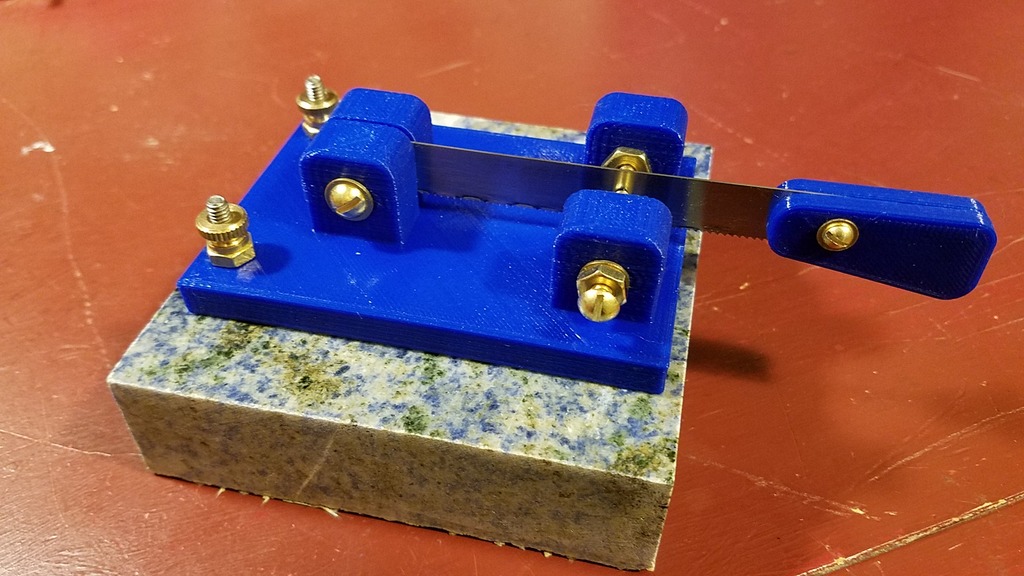
Morse Code Sideswiper (Cootie) Key
prusaprinters
<p>Mar 7 2018: Added an STL file to print two small wrenches to assist adjustment of the contacts. See photos.</p> <p>This is my take on a Morse Code sideswiper key, (also called cootie keys.) Unlike the traditional telegraph key which uses an up-and-down motion, the sideswiper makes contact on either side of a flexible arm, making for much less hand and wrist fatigue.</p> <p>This key uses a short length of hacksaw blade as the lever arm; this is a ham radio tradition for these kind of keys, which were often home-brewed out of inexpensive materials on hand.</p> <p>This key was inspired by the design found here: <a href="https://www.thingiverse.com/thing:1662382">https://www.thingiverse.com/thing:1662382</a></p> <h3>Print Settings</h3> <p><strong>Printer Brand:</strong></p> <p>Robo 3D</p> <p class="detail-setting printer"><strong>Printer: </strong> <div><p>R1 ABS + PLA Model</p></div> <p><strong>Rafts:</strong></p> <p>Yes</p> <p class="detail-setting supports"><strong>Supports: </strong> <div><p>No</p></div> <p><strong>Resolution:</strong></p> <p>0.2</p> <p class="detail-setting infill"><strong>Infill: </strong> <div><p>30%</p></div> <p><strong>Notes:</strong></p> <p>You will get a little bridging in the wire vias, but it is easily cleaned out, and this is under the base and not visible when the key is in use.rnrnI printed this in PETG and PLA - I like the PLA version better, less flexing.rnrn</p> <h3>Post-Printing</h3> <p><strong>What you will need</strong></p> <div><p>A piece of hacksaw blade about 125mm long. rn brass or stainless steel #8 hardware for assembly.rnbrass or stainless steel #4 hardware to attach the finger piecesrnabout 2 feet of 20 or 22 ga solid wirern</p></div> <p class="detail-title"><strong>Prepare the hacksaw blade</strong></p> <div><p>Cut or break the blade to length (wear goggles!).rnSand off the paint on the blade. If you don't want to do the whole blade, make sure the portions where the supports and contacts are clean of paint.rnYou can use ScotchBrite to shine up the surface a bit after the paint is removed.rnFinish the cut end with a file to remove sharp edges and burrs. (wear goggles!)rnMeasure 10mm from the cut end, and drill an 11/64th hole (5mm) centered on the blade. Go slow, the steel blade is hard. Wear goggles!rn</p></div> <p class="detail-title"><strong>Preparing the connecting wires.</strong></p> <div><p>Break the shanks off of three #8 ring tongue terminals. Strip the insulation off one piece of 20 - 22 ga wire, this is the wire that will be used to connect to the hacksaw blade.rnrnSolder the bare wire to one ring tongue, and two lengths of insulated 20 - 22 ga wire to the other two. See the photo.</p></div> <p class="detail-title"><strong>Assemble the pieces</strong></p> <div><p>Poke the bare wire into the hole between the support pillars, slide the hacksaw blade in as well, and use an awl to line up the holes. Use the bolt, washers, and nut to secure the hacksaw blade - make sure it is level, and tighten securely.rnrnDrop a wire with a ring tongue on it through each of the wire holes, on the base just inside the contact pillars.rnrnThread a nut all the way onto each of the contact bolts, and add a flat washer. Push the assembly through the contact holes and place the ring tongue over it on the inside of the pillar. Add a nut to secure the assembly. You can change the contact spacing by adjusting the nuts to give the right spacing when both nuts are tightened.rnrnAttach the finger pieces to the end of the blade with the #4 screw, washers and nut.rnrnrn</p></div> How I Designed This =================== <p>I wanted the support and contacts as close to the base as possible to reduce flexing. I thickened the supports to make them more rigid.rnAlso, the connecting wires are routed internal to the support pillars, which makes them less visible. rnrnThis design was done using Fusion 360.</p> </p></p></p> Category: Electronics
With this file you will be able to print Morse Code Sideswiper (Cootie) Key with your 3D printer. Click on the button and save the file on your computer to work, edit or customize your design. You can also find more 3D designs for printers on Morse Code Sideswiper (Cootie) Key.
